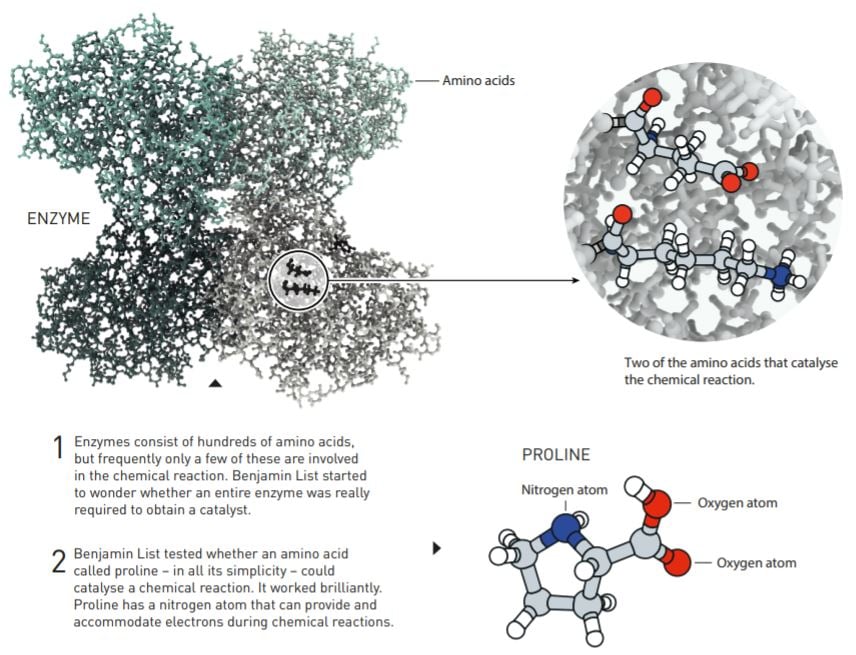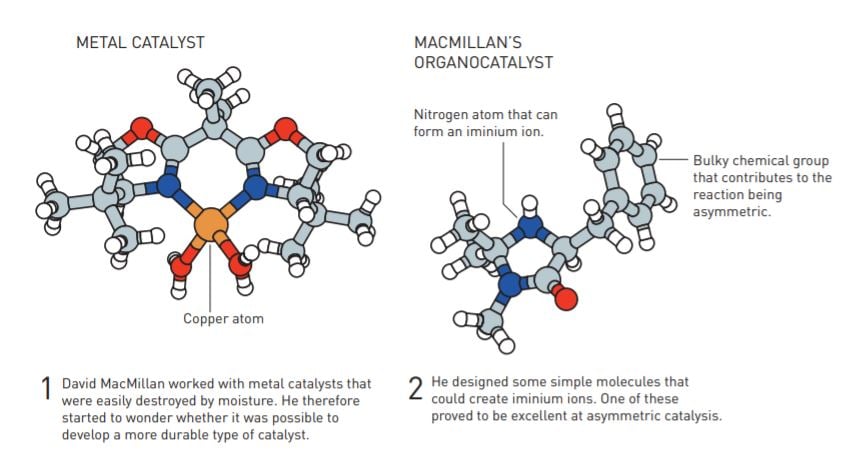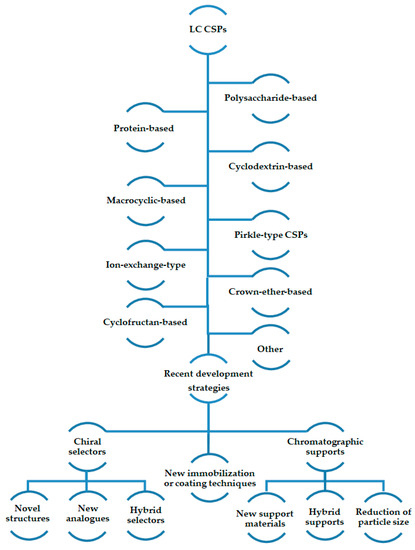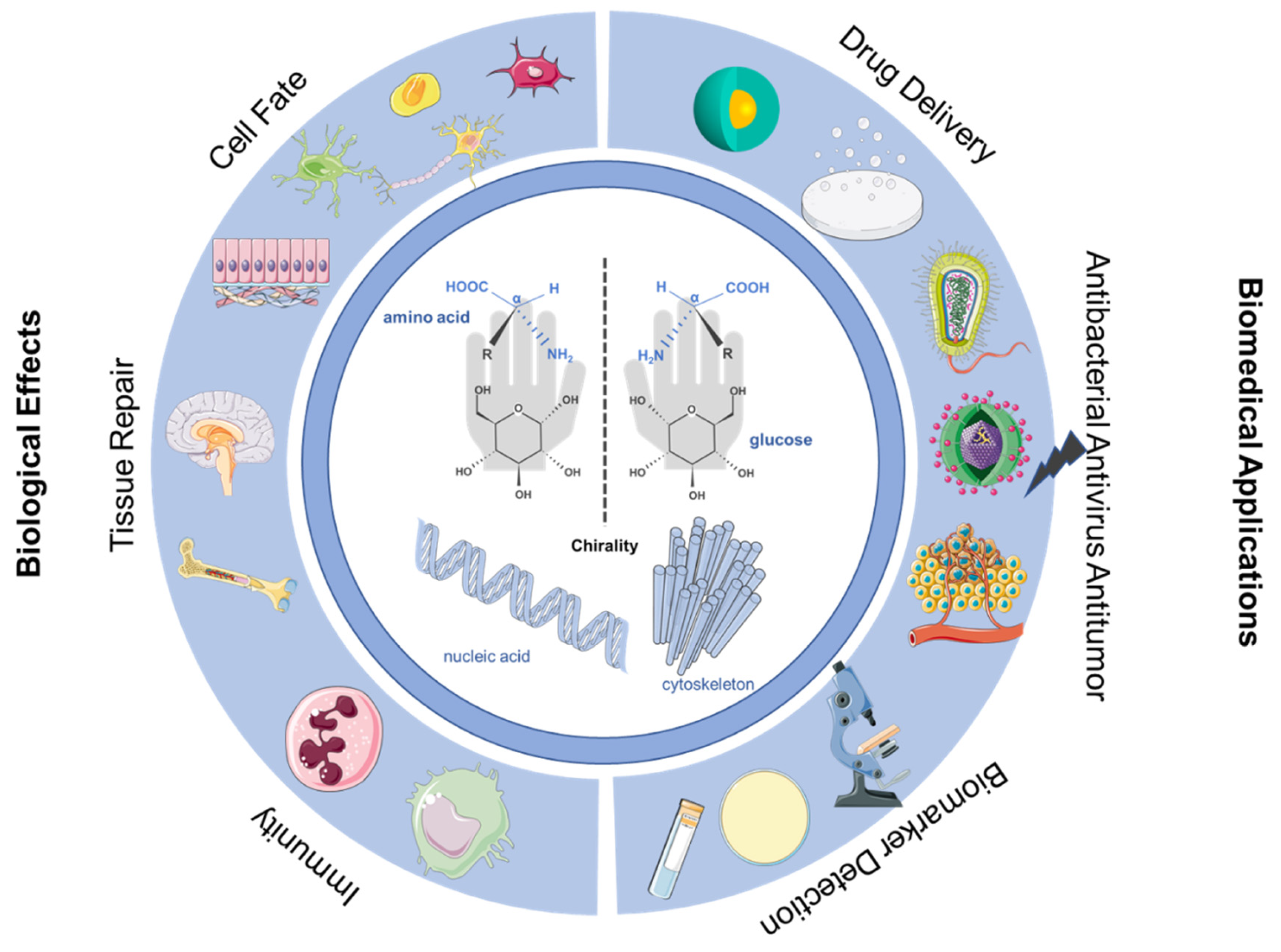Introduction
Chirality, the property of molecules to exist in forms that are non-superimposable mirror images of each other, is a fundamental aspect of chemistry that has significant implications across various scientific fields. From pharmaceuticals to materials science, the ability to manipulate and understand chirality is driving innovations and opening up new possibilities. This blog explores the latest advancements in chiral technology and synthesis, potential future applications, and the most promising current research developments in the field.
Advances in Chiral Technology and Synthesis
New and ingenious tool for molecule building: Organocatalysis
Every new tool that chemists have introduced to their repertoire has enhanced the accuracy of their molecular constructions. Over time, chemistry has evolved from a rudimentary process to one resembling fine craftsmanship. This progress has significantly benefited humanity, and many of these innovations have been recognized with the Nobel Prize in Chemistry.

However, when comparing nature’s chemical creativity to our own, humans have lagged far behind. Evolution has developed highly specialized tools, namely enzymes, to construct the molecular structures that provide life with its shapes, colors, and functions. Early chemists, upon isolating these intricate natural compounds, could only marvel at them. Their own methods for molecular construction were crude and imprecise, often resulting in numerous unwanted byproducts when they attempted to replicate nature’s creations.
New tools for finer chemistry
Each new tool that chemists have added to their toolbox has increased the precision of their molecular constructions. Slowly but surely, chemistry has progressed from chiselling in stone to something more like fine craftsmanship. This has been of great benefit to humanity and several of these tools have been rewarded with the Nobel Prize in Chemistry.
Recent years have seen remarkable progress in asymmetric synthesis, a process that produces chiral molecules with high enantiomeric purity. Advances in the synthetic tools (chiral catalysts and reagents) have enabled chemists to develop more efficient and selective synthetic pathways. For example, novel organocatalysts and organo metal catalysts have been designed to promote asymmetric reactions with unprecedented precision. These innovations not only improve yield and purity but also reduce the environmental impact of chemical synthesis.
Asymmetric Organocatalysts
Benjamin List (Nobel Laurate 2021 Chemistry) thinks outside the box…

Benjamin List started to think about how enzymes actually work. They are usually huge molecules that are built from hundreds of amino acids. In addition to these amino acids, a significant proportion of enzymes also have metals that help drive chemical processes. But – and this is the point – many enzymes catalyse chemical reactions without the help of metals. Instead, the reactions are driven by one or a few individual amino acids in the enzyme. Benjamin List’s out-of-the-box question was: do amino acids have to be part of an enzyme in order to catalyse a chemical reaction? Or could a single amino acid, or other similar simple molecules, do the same job?
David MacMillan (Nobel Laurate 2021 Chemistry) coins the term organocatalysis

David MacMillan leaves sensitive metals behind… …and develops a simpler form of catalyst
Biocatalysis, which uses natural or engineered enzymes to catalyze chemical reactions, has emerged as a powerful tool in chiral synthesis. Enzymatic methods offer several advantages, including mild reaction conditions, high selectivity, and the potential for green chemistry approaches. Advances in protein engineering have enabled the creation of enzymes with tailored activity and selectivity, expanding the toolkit available for chiral synthesis.
Chiral Resolution Techniques
Separating enantiomers is a crucial step in producing chiral compounds for various applications. Advances in chromatographic methods, chiral chromatography, such as high-performance liquid chromatography (HPLC) and supercritical fluid chromatography (SFC), have significantly improved the efficiency and scalability of chiral resolution processes. Further the development of novel CSPs has revolutionized chiral separation techniques. A summary is presented in the graphical abstract below.

Recent Approaches in Developing New Chiral Stationary Phases (CSPs) for Liquid Chromatography (LC)
Additionally, chiral membrane separation techniques are being developed to provide an alternative to traditional chromatographic methods, offering the potential for continuous and cost-effective resolution.
Computational chemistry is playing an increasingly important role in optimizing chiral resolution processes. Simulations and modeling allow researchers to predict the behavior of chiral molecules in different environments, helping to identify the most effective separation techniques. These computational tools are essential for designing more efficient and selective resolution processes.
Analytical Techniques for Chirality
The characterization of chiral compounds is critical for both research and industrial applications. Innovations in chiral chromatography and spectroscopy have led to the development of more sensitive and accurate detection methods. For example, advanced circular dichroism (CD) and vibrational circular dichroism (VCD) techniques provide detailed information about the chiral properties of molecules.
High-throughput screening methods are becoming increasingly important in chiral research. These techniques allow for the rapid analysis of large numbers of samples, accelerating the discovery and optimization of chiral compounds. The development of automated and miniaturized analytical tools is enhancing the efficiency and effectiveness of chiral analysis.
Potential Future Applications in Various Fields
Pharmaceuticals and Drug Development
Chirality is of paramount importance in pharmaceuticals, as the two enantiomers of a chiral drug can have very different biological activities. Single enantiomer version of the already approved racemic therapeutic (namely chiral switch) has also been brough to market to improve drug therapy. Advances in chiral technology are enabling the development of drugs with enhanced efficacy and safety. For example, the selective synthesis of active enantiomers can reduce side effects and improve therapeutic outcomes. Personalized medicine is also benefiting from chiral technology, as patient-specific treatments can be tailored based on the chirality of drugs.
Next-generation chiral drugs are in development, targeting a wide range of conditions. These drugs leverage the unique properties of chiral molecules to achieve better therapeutic effects. For example, chiral drugs are being developed to target specific protein conformations, enhancing their effectiveness in treating diseases like cancer and neurodegenerative disorders.
Materials Science and Nanotechnology
Chirality is playing an increasingly important role in materials science and nanotechnology. Chiral materials are being developed for advanced applications, such as sensors and electronic devices. These materials exhibit unique optical, electronic, and mechanical properties, making them suitable for a wide range of high-tech applications.
In nanotechnology, chirality is being harnessed to develop new nanomaterials with enhanced performance. For example, chiral nanoparticles can be used in drug delivery systems to target specific cells or tissues, improving the efficacy of treatments. Additionally, chiral photonic and optoelectronic devices are being developed to manipulate light and signals in novel ways, opening up new possibilities in communication and computing.
Agriculture and Food Science
Chirality is also making an impact in agriculture and food science. Chiral pesticides and herbicides are being developed to provide more effective and environmentally friendly solutions for crop protection. These enantioselective agrochemicals can target specific pests or weeds while minimizing harm to beneficial organisms and the environment.
In food science, chirality is being used to enhance flavors and aromas. Chiral compounds can have distinct sensory properties, and understanding these differences allows for the development of more appealing food products. Additionally, chiral nutritional supplements, such as specific enantiomers of vitamins and amino acids, are being formulated to improve bioavailability and effectiveness, offering greater health benefits to consumers. Read more @ <https://chiralpedia.com/blog/chiral-chemistry-in-everyday-life-hidden-handedness-around-us/>
Chiral Bio-interface: Biological Effects and Biomedical Applications
Studying the construction of chiral interfaces and their influence on biological processes, particularly cell fate, tissue repair, and immune response, is crucial for comprehending natural chirality and advancing its applications. Numerous studies have focused on developing diverse types of chiral interfaces and investigating their effects on cells, tissues, or organisms, significantly advancing our understanding of chiral mechanisms and expanding applications in biology, medicine, and related fields. Moreover, insights into chiral interface materials facilitate the application of chirality in diagnostics and therapeutics. Recent research has demonstrated the biological impacts of chiral interfaces in drug delivery, antibacterial, antivirus, antitumor activities, and biological signal detection. These findings enhance our understanding of how chiral interface properties influence cellular and organismal behaviors, thereby improving the biomedical applications of chiral interfaces. Explore the detailed insights and scientific discussions in the full article at https://doi.org/10.3390/molecules28155629.

Chiral Bio-Interface
Chirality’s Pivotal Role in Biomedical Science. This comprehensive illustration demonstrates how chirality influences a wide range of biological effects and biomedical applications. From determining cell fate and facilitating tissue repair to enhancing immunity, the central concept of chirality impacts numerous aspects of health and disease management. The image also showcases how chirality is harnessed in advanced drug delivery systems and in the development of antibacterial, antivirus, and antitumor therapies. Additionally, its role in biomarker detection underscores the importance of chirality in diagnostic advancements.
Current Research and Promising Developments
Academic and Industrial Research
Key research institutions and companies are leading the way in chiral science. Notable academic labs are pushing the boundaries of what is possible with chiral technology, while industry leaders are applying these innovations to create new products and solutions. Collaborative projects and multidisciplinary approaches are essential for advancing the field, combining expertise from chemistry, biology, materials science, and engineering.
Funding trends indicate strong support for chiral research, with major grants being awarded to projects that demonstrate significant potential. Government agencies, private foundations, and industry partners are investing in the development of new chiral technologies and applications, recognizing their transformative potential.
Breakthrough Discoveries
Recent high-impact publications and discoveries highlight the rapid progress being made in chiral science. For example, researchers have developed new methods for synthesizing chiral molecules [asymmetric (metal) catalysis and asymmetric (organo) catalysis)] with unprecedented selectivity and efficiency. Case studies of innovative research projects demonstrate the practical applications of these discoveries, showcasing how chiral technology can solve real-world problems.
Insights from leading researchers provide valuable perspectives on the future of chiral science. Interviews, news and quotes from experts reveal the excitement and optimism surrounding recent breakthroughs, as well as the challenges that remain to be addressed.
Future Directions and Challenges
Despite the significant advances in chiral technology, several challenges remain. Technical hurdles, such as achieving high enantiomeric purity and scaling up production processes, need to be overcome. Emerging areas of interest, such as the role of chirality in quantum computing and biotechnology, offer exciting opportunities for future research.
The future of asymmetric synthesis – particularly in designing catalysts – holds exciting promise thanks to the integration of Artificial Intelligence (AI) and Machine Learning (ML). AI and ML are poised to revolutionize asymmetric synthesis by accelerating catalyst discovery, expanding our toolkit, and enabling the efficient construction of complex chiral molecules. Exciting times lie ahead for chemists and the field of catalysis
The long-term vision for the future of chirality in science and industry is one of continued innovation and discovery. Researchers and industry leaders are working towards a future where chiral technology is seamlessly integrated into a wide range of applications, improving the quality of life and advancing scientific understanding.
Conclusion
Chirality is a fundamental aspect of chemistry that has far-reaching implications across various scientific fields. Advances in chiral technology and synthesis are driving innovations and opening up new possibilities in pharmaceuticals, materials science, agriculture, and beyond. Current research and promising developments highlight the transformative potential of chiral science, and future directions offer exciting opportunities for continued progress. As we explore the future of chirality, we can look forward to a world where the hidden handedness of molecules plays an ever more prominent role in shaping our technological and scientific landscape.
Further Reading
https://www.nobelprize.org/prizes/chemistry/2021/popular-information/
https://www.nobelprize.org/prizes/chemistry/2001/popular-information
https://chiralpedia.com/blog/chiral-chemistry-in-everyday-life-hidden-handedness-around-us/
https://chiralpedia.com/news.php
https://chiralpedia.com/quotes.php
Guo, L.; Guo, Y.; Wang, R.; Feng, J.; Shao, N.; Zhou, X.; Zhou, Y. Interface Chirality: From Biological Effects to Biomedical Applications. Molecules 2023, 28, 5629. https://doi.org/10.3390/molecules28155629
McGown A, Nafie J, Otayfah M, Hassell-Hart S, Tizzard GJ, Coles SJ, Banks R, Marsh GP, Maple HJ, Kostakis GE, Proietti Silvestri I, Colbon P, Spencer J. Chirality: a key parameter in chemical probes. RSC Chem Biol. 2023 Aug 8;4(10):716-721. doi: 10.1039/d3cb00082f. PMID: 37799583; PMCID: PMC10549247.
Eliel, E. L., & Wilen, S. H. (1994). Stereochemistry of Organic Compounds. Wiley-Interscience.
Morrison, R. T., & Boyd, R. N. (2010). Organic Chemistry. Prentice Hall.
Pasteur, L. (1848). “Researches on the Molecular Asymmetry of Natural Organic Products”. Comptes Rendus Hebdomadaires des Séances de l’Académie des Sciences, 26, 535-538.
Nguyen, L. A., He, H., & Pham-Huy, C. (2006). “Chiral Drugs: An Overview”. International Journal of Biomedical Science, 2(2), 85-100.
Noyori, R. (2002). “Asymmetric Catalysis: Science and Opportunities”. Angewandte Chemie International Edition, 41(12), 2008-2022.
Wolf, C. (2008). “Dynamic Stereochemistry of Chiral Compounds: Principles and Applications”. The Royal Society of Chemistry.
Cintas, P. (2016). “Pasteur’s Chiral Molecules”. The Chemical Record, 16(6), 3008-3018.
Mislow, K. (2002). “Molecular Chirality”. Topics in Stereochemistry, 6, 1-41.
Berova, N., Nakanishi, K., & Woody, R. W. (2000). Circular Dichroism: Principles and Applications. Wiley-VCH.
Jacques, J., Collet, A., & Wilen, S. H. (1981). Enantiomers, Racemates, and Resolutions. Wiley
Teixeira, J., Tiritan, M. E., Pinto, M. M. M., & Fernandes, C. (2019). Chiral Stationary Phases for Liquid Chromatography: Recent Developments. Molecules, 24(5), 865. doi:10.3390/molecules24050865
Other Blogs on #ChiralityonFriday
1. Introduction to Chirality: Understanding the Basics
2. Molecular Handedness: How Chirality Shapes Molecules
3. Chirality in Nature: From DNA to Snail Shells
4. The Chemistry of Taste and Smell: How Chirality Affects Senses
5. Chiral Chemistry in Everyday Life: Hidden Handedness Around Us
6. Chirality in Pharmaceuticals: The Impact of Molecular Handedness on Medicine
7. Chirality-in-materials-science-designing-with-handedness/
8. Chirality in Space: Cosmic Asymmetry and the Origins of Life
9. The Future of Chirality: Innovations and Emerging Trends
10. Chirality and You: Understanding and Appreciating Molecular Handedness


Your article has covered a lot of areas and its potential impact for the future. Well compiled Sir.